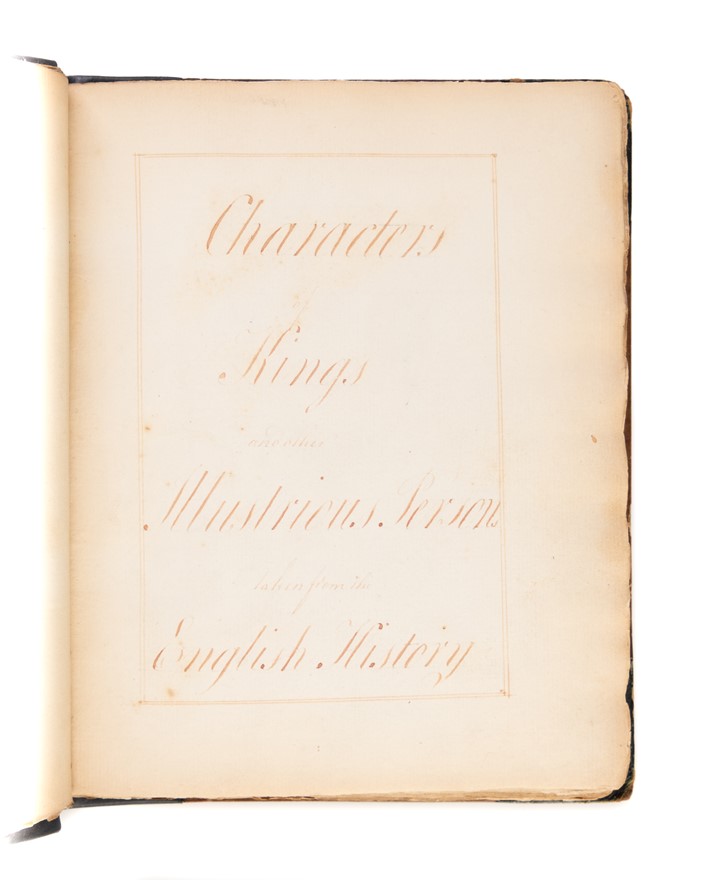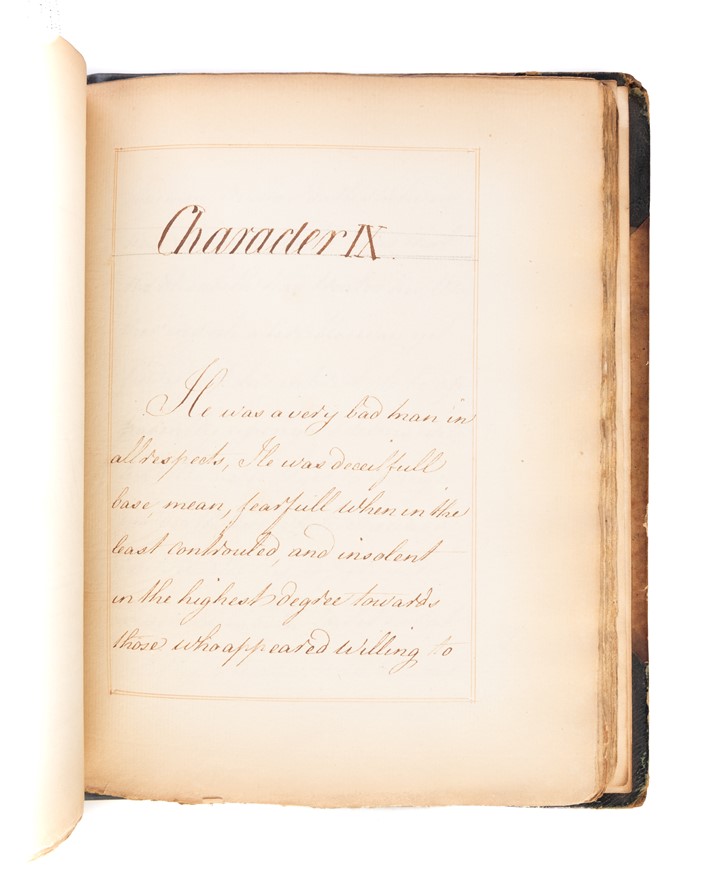Characters of Kings and other Illustrious Persons taken from the English History.
FREDERICK Prince, duke of York and Albany (c. 1777].)
£2800.00
Please contact us in advance if you would like to view this book at our Curzon Street shop.
MANUSCRIPT BIOGRAPHIES OF KINGS BY A YOUNG PRINCE
Manuscript in brown ink. Small 4to (210 x 165mm). 130pp., written on the rectos only, each leaf ruled in red, table of contents at the end. Paper now a little browned in places and chipped at the edges; leaves watermarked with a lion rampant beneath a crown with the words 'Vryheid' beneath the lion and 'Pro Patria Eiusque Libertate' in a band around the lion [the watermark is of a Flemish papermaker producing high quality paper in the 18th and 19th century]. Later blue morocco-backed marbled boards, spine lettered in gilt, old marbled endleaves bound in at the beginning and end (rebacked with a new spine with the old back strip laid down on the new matching blue leather, front end-leaves now loose, a little bumped and rubbed at the edges, some scuffs to the boards).
[?The Dutch House, Kew Palace, c. 1777].
An exercise fit for a young Prince after the so-called "nursery revolution": eleven short biographies of "Kings and Illustrious Persons" prepared by the young Prince Frederick - favourite son of George III and today remembered for his "considerable influence on the history of the British army".
The short lives described by Prince Frederick are: Becket [Thomas Becket], Edward I, Henry V, Cardinal Beaufort [Henry Beaufort], Richard III, Cardinal Wolsey, Henry VIII, Earl of Essex, James I, Archbishop Laud and Charles I. The first biography (Becket) is signed and dated "Frederick / Nov 15 1777". Curiously on the initial blank leaf is the inscription: "Frederick / This Book begun July 15. 1778 and finished September 16. 1778". Some leaves [not from Characters of Kings...] have been excised from the volume so this later date may relate to another exercise which was later removed.
The biographies do not appear to have been copied directly from one source and the occasional syntax errors and the (at times) childlike viewpoint suggest they may be original compositions. Thomas Becket is said to have been "haughty to his inferiors ... and cringing to his superiors ... he openly opposed the King and without considering the obligations. He had to him treated him with all possible violence [sic]".
Of Richard III: "He was intriguing, dark, deecetfull [sic], treacherous, and never considered by what means he attained his ends. His steps to obtain the throne were so horrid as hardly to be conceived ...", Frederick concedes though: "He had however some few qualities worthy of commendation. He was brave, and active tho: generally in a bad cause. some have collected from his conduct after he mounted the throne that tho he was cruel at first yet it was only till he had firmly seated himself upon it and that then he would probably have reigned with honor and justice".
King George III took a keen interest in the education of all his children and Prince Frederick was taught - alongside his brother, the Prince of Wales and future George IV - by a carefully selected team of tutors and guardians at the Dutch House, Kew Palace.
"In educating them he [George III] followed the practice of the French monarchy in appointing at the appropriate time a governor and sub-governor and a preceptor and sub-preceptor, the governor being responsible for discipline and morals and the preceptor for the actual teaching" (M. L. Clarke, "The Education of the Royalty in the Eighteenth Century: George IV and William IV, British Journal of Educational Studies, 1978, p.73-87).
The two Princes were taught by a number of different people in these roles before King George affected what has been described as a "nursery revolution" in May 1776 (described by Edmund Burke in a letter to Richard Champion, May 30th 1776) when he changed the Princes' tutors and replaced them with the Duke of Montagu as Governor, George Hotham as sub-governor, Richard Hurd (the Bishop of Lichfield and Coventry) as preceptor and William Arnald as sub-preceptor.
"Soon after his appointment Hurd drew up a Plan of Studies which he submitted to the king, who expressed 'the most active approbation of every part of it'. Assuming that the princes already had 'a competent skill in the languages', Hurd divided the subjects to be studied into six: Religion, Morals, History, Government and Law, Mathematics and Natural Philosophy, Polite Literature. Religion was to be treated under the two heads of Natural and Revealed Religion ... the study of modern history would be mainly directed to that of France and of England, especially from the Tudors to the Revolution of 1688. History teaching was to be 'executed as much as possible in the way of examination, when the several periods have been studied, and not by way of lecture'".
This manuscript provides a glimpse inside the school-room at Kew as Prince Frederick and the Prince of Wales were provided with - what M L Clarke argues - was a remarkably well-rounded education more akin to that provided at the English universities than schools such as Westminster or Eton. At the time that the manuscript was produced Frederick had already been elected to the bishopric of Osnabrück (in February 1764 - when he was six months old) and a couple of years later he was gazetted a colonel in the army by his father and sent to Hanover to learn French and German and study military manoeuvres. Frederick's later military career was far from distinguished on the battlefield but he is remembered, importantly, as having:
"... considerable influence on the history of the British army. He supported the commanders' efforts to revive military spirit with some success; he looked after the soldiers and their comforts, and sternly put down the influence of personal favouritism. Despite his involvement in the Mary Anne Clarke scandal, he did much to eradicate political jobbery in military appointments, and systematic corruption" (ODNB).
Provenance: William Upcott (1779-1845), antiquary and manuscript collector. Note signed "William Upcott" on one of the front endleaves: "Written by His Royal Highness Frederick the late Duke of York at the age of Fifteen years, and has his signature on two leaves". Beneath this is Upcott's acquisition note: "Purchased at a sale of autographs January 20 1836 xxd" [B. Wheatley, An Interesting Collection of Autograph Letters, original state documents, and other papers, from the collection of Sir Julius Caesar, Master of the Mint, &c.; including autograph letters of the Kings and Queens of England, unpublished manuscripts in the autographs of the Dukes of York and Gloucester, Oliver Cromwell, ...]. Sold at the posthumous sale of Upcott's manuscripts by R. H. Evans, 22nd June 1846, lot 207 (the lot label in still pasted to one of the marbled endleaves).
Later Provenance: Purchased from a New Hampshire book dealer in March 2020.
Stock Code: 243074








